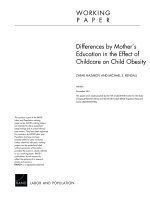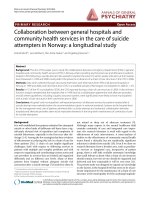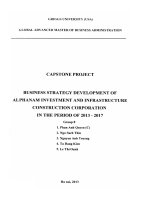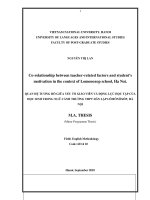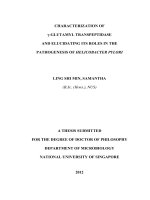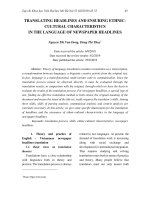Co-relationship between teacher-related factors and student's motivation in the context of Lomonoxop school, Hanoi = Quan hệ tương hỗ giữa yếu tố giáo viên và đ
Bạn đang xem bản rút gọn của tài liệu. Xem và tải ngay bản đầy đủ của tài liệu tại đây (831.07 KB, 63 trang )
1
VIETNAM NATIONAL UNIVERSITY, HANOI
UNIVERSITY OF LANGUAGES AND INTERNATIONAL STUDIES
FACULTY OF POST-GRADUATE STUDIES
NGUYỄN THỊ LAN
Co-relationship between teacher-related factors and student’s
motivation in the context of Lomonoxop school, Ha Noi.
QUAN HỆ TƯƠNG HỖ GIỮA YẾU TỐ GIÁO VIÊN VÀ ĐỘNG LỰC HỌC TẬP CỦA
HỌC SINH TRONG NGỮ CẢNH TRƯỜNG THPT DÂN LẬP LÔMÔNÔXỐP, HÀ
NỘI
M.A. THESIS
(Minor Programme Thesis)
Field: English Methodology
Code: 60 14 10
Hanoi, September 2010
2
VIETNAM NATIONAL UNIVERSITY, HANOI
UNIVERSITY OF LANGUAGES AND INTERNATIONAL STUDIES
FACULTY OF POST-GRADUATE STUDIES
NGUYỄN THỊ LAN
Co-relationship between teacher-related factors and student’s
motivation in the context of Lomonoxop school, Ha Noi.
QUAN HỆ TƯƠNG HỖ GIỮA YẾU TỐ GIÁO VIÊN VÀ ĐỘNG LỰC HỌC TẬP CỦA
HỌC SINH TRONG NGỮ CẢNH TRƯỜNG THPT DÂN LẬP LÔMÔNÔXỐP, HÀ
NỘI
M.A. THESIS
(Minor Programme Thesis)
Field: English Methodology
Code: 60 14 10
Supervisor: Van Thi Thanh Binh, M.A
Hanoi, September 2010
6
LIST OF TABLES AND FIGURES
1. Table1: Distribution of teacher’s level of motivation and commitment on student’s
motivation.
2. Table 2: Distribution of teacher behavior on student’s motivation
3. Table 3: Distribution of teaching method on student’s motivation
4. Table 4 : Distribution of teacher’s diversity on student’s motivation
5. Table 5: Distribution of teacher’s tests on student’s motivation.
6. Table 6: Distribution of teacher’s feedback on student’s motivation
7. Table 7: Distribution of classroom rules on student’s motivation.
8. Table 8: Degrees of influence that personal characteristics of teachers have on
student’s motivation.
9. Table 9: Degrees of influence that classroom management factors have on student’s
motivation.
10. Chart 1: How students like to learn with teacher’s competence.
11. Chart 2: How students like to learn with teacher’s empathy.
7
TABLE OF CONTENTS
Declaration i
Acknowledgements ii
Abstract iii
List of tables and figures iv
PART 1: INTRODUCTION 1
1.1 Rational 1
1.2 Method of the study 2
1.3 Scope and objectives of the study 2
1.4 The research questions 2
1.5 Design of the study. 2
PART 2: DEVELOPMENT 4
CHAPTER 1: LITERATURE REVIEW 4
1.1. Definition of terminology 4
1.1.1 Motivation 4
1.1.2 Demotivation 5
1.2 The role of motivation in foreign language learning 6
1.3 Student’s perception of motivating/ demotivating factors. 8
1.3.1 Motivating factors 8
1.3.1.1. Parental influences 8
1.3.1.2 Teachers 8
1.3.1.3 Learner group 9
1.3.1.4 School 9
1.3.2 Demotivating factors 10
1.3.2.1 Demotivating factors identified by Dörnyei 10
1.3.2.2 Demotivating factors identified by Oxford 12
1.4 Teachers as motivating/ demotivating factors 13
1.5 Characteristics of young learners. 16
1.5.1 Twelve year old young learners 16
8
1.5.2 Young learners in Lomonoxop schoo 17
1.6 Summary 17
CHAPTER 2: THE STUDY 18
2.1 The context 18
2.2 The informants 19
2.3 Methods of data collection 19
2.4 The survey questionnaire 19
2.5 Summary 20
CHAPTER 3: DATA ANALYSIS AND DISCUSSION.
3.1 Personal characteristics of teachers. 21
3.1.1 Level of motivation and commitment. 21
3.1.2 Teacher competence 23
3.1.3 Teacher empathy 24
3.2 Classroom management factors 25
3.2.1 Teacher behavior. 25
3.2.2 Teaching method 27
3.2.3. Classroom rules 31
3.3 Major findings and discussions 33
3.3.1 On personal characteristics of teachers 33
3.3.2 On classroom management factors 34
PART 1: CONCLUSIONS 38
1. Summary 38
2. Implication for teaching 38
3. Limitations of the study 40
4. Suggestions for further study 40
REFERENCES 41
APPENDIXES I
9
PART 1: INTRODUCTION
1.1 Rationale
“In an ideal world, all learners are eager to learn because they are driven by their
inborn curiosity to explore the world, and the learning experience therefore is a constant
source of intrinsic pleasure for them. Reality, however, rarely lives up to these ideals.”
(Dörnyei, 2001b: 123)
“One who teaches students must understand what motivates his/her students”
(Andrews, Houston, & Bryant, 1981).
During the course of my studies for my Masters degree, I have found myself
increasingly interested in the psychological basis of language acquisition, and attempts to link
the psychological with the linguistic in the second/foreign language learning field. As an
English teacher working in the Vietnamese secondary and high school, teaching young
learners of grade 6, one of my greatest challenges is accommodating the needs of demotivated
students and find ways to motivate them in learning. In my opinion, there are many things that
motivate students to learn such as teachers, parents, friends, learning environment, etc. From
the experience of being a teacher for five years, I have a feeling that teachers play the most
important role in shaping motivation in students. Moreover, as a young teacher, I have been
making efforts to make students love their learning more and more. It is a fact that my efforts
to adapt my teaching to my students have been an ongoing process of experimentation and
change. Much of this has been guided by the remarks from my colleagues in the English group
at my school and by my student’s different ideas about their teachers. Many of their comments
and most of my student’s ideas have revolved around how teachers motivate their students to
learn. According to my colleagues, I need to pay more attention to manage the class, organize
the board, speak suitable amount of English in class and choose suitable methodology in
teaching. Besides, my students also gives me a lot of ideas on how they like their teachers to
be. One way in which I feel I have had some success with this issue is by increasing my
awareness of, and openness to, student’s opinions about learning English in general and my
lessons in particular. It is thus professional concern, as well as personal curiosity that has
motivated my choice of dissertation topic.
10
1.2 Method of the study
In this research, I employed quantitative methods to analyze the data collected and draw on
conclusions and remarks.
In order to achieve the purpose of the study, one questionnaire to survey the
relationship between teacher factors and student’s motivation was developed and
administered. Besides, the teacher also conducted informal chats with the students so as to see
their views and opinions about the teacher factors that affect their English learning.
1.3 Scope and objectives of the study
The study focus on working out the relationship between teacher factors and student’s
motivation so as to help teachers in Lomonoxop school in general and myself in particular
improve our teaching and better fit the need of the student. Pedagogical implications for
teaching and limitations of the study were given at the end of the paper
1.4 The research questions
The study was intended to answer the following questions:
What are teacher –related factors that motivate the young learners in Lomonoxop
private school, Ha Noi to learn English?
Sub-questions:
1. What are teacher’s personal factors that motivate the young learners in
Lomonoxop private school, Ha Noi?
2. What are teacher’s classroom management factors that motivate the young
learners in Lomonoxop private school, Ha Noi?
In order to achieve the aims and objectives of the study, I employed a questionnaire
survey to collect relevant data, which was analyzed statistically and interpretatively.
1.5 Design of the study
The study is divided into 3 main parts.
Part one is an introduction to the research, where matters such as rationale, methods of
study, scope and objectives of the study and the research questions are discussed . Part 2
development in cludes three chapters. Chapter 1 is an attempt to review the theoretical
11
background in the light of which the research matters will be discussed. Chapter 2 discusses
the context of study, data collection methods. Chapter 3 analyses the data collected to answer
specifically the research questions set forth for the study. In Part three Conclusion, findings
and discussions as well as a summary of the study are given and some implications for
teaching are suggested. Suggestions for further study are also provided in this part.
12
PART 2: DEVELOPMENT
CHAPTER 1: LITERATURE REVIEW
1.1 Definition of terminology
1.1.1 What is motivation?
Motivation is central to human activity. Anything that drives human beings to act is
related to motivation. In such fields as economy and law, motivation is defined as internal
drives for human behavior. These drives in turn originate from needs, but not all needs are
drives. Only those which are recognized to be realizable in certain circumstances become the
motivation to act. Because motivation is related to needs, it is internal to human beings.
In a larger sense, motivation is related to satisfaction of needs and desire, whether it be
internal or external to the person. According to Webster’s dictionary (1913), to motivate
means to provide with a motive, need or desire that causes a person to act. Oxford Advanced
Learner’s Dictionary equates “to motivate” with “to be the reason for somebody’s action, to
cause someone to want to do something”. Theoretically, any conscious action can be
explained in view of motivation. Broadly speaking, motivation is divided into two types:
Intrisic and extrinsic. A student learning English because he/ she knows he/ she will be more
successful in future career is clarified as an intrinsically motivated student. On the other hand,
there are extrinsically motivated students who tolerate for the final test.
Gardner’s (1985) view of motivation arises from his socio- educational model. He
states that motivation is concerned with the question “Why does an organism behave as it
does” and involves 4 aspects:
1. A goal
2. An effort
3. A desire to attain the goal
4. Favorable attitude toward the activity in question.
Motivation then refers to the combination of desire and effort made to achieve a goal.
It is considered in the relationship between the individual’s rationale for any activity with
range of behaviors and degree of effort made to achieve the goals.
13
It is also worth noting that motivation has close relationship with other affective
factors such as self confidence, anxiety and perceived competence. All these together work to
undermine achievement. In section 2.2 of this chapter, we will take a closer look at the role of
motivation in foreign language learning.
1.1.2 What is demotivation
Traditionally, motivation has been understood and studied as a multifaceted construct
consisting of various influences with a positive effect. Motivational factors or motives have
been considered as kind of inducements with the effect of energizing ongoing action (Dörnyei
2001). However, there is another aspect to motivation that has been left with little attention.
Just as there are influences that have a positive effect on motivation, there are also those that
have a detrimental effect on motivation. These influences are called demotivating influences.
The notion of demotivation is relatively new and has not been fully adopted yet in the field of
the second/foreign language learning research. However, Dörnyei (2001) has attempted to
provide a definition for it. Accordingly, demotivation ”concerns specific external forces that
reduce or diminish the motivational basis of a behavioral intention or an ongoing action”
(Dörnyei 2001:143). Thus, demotivation could be regarded as the negative counterpart of
motivation. Similarly, demotives could be regarded as the negative counterparts of motives.
Furthermore, a demotivated learner is someone who has lost his or hers interest for some
reason. The loss of interest can derive from various sources of demotivation. For instance, a
teacher who cannot control the class or a boring textbook can act as a demotive for a learner.
However, the notion of demotivation cannot be related to every reluctant learner. Dörnyei
(2001) has distinguished at least three negative factors that cannot be referred to as demotives.
Firstly, there are powerful distractions, e.g. watching television instead of doing one’s
homework. These cannot be regarded as demotives because they do not carry negative value.
Hence, instead of reducing motivation they distract a learner by presenting a more attractive
alternative. Secondly, gradual loss of interest cannot be regarded as a demotive because
demotives are specific factors or incidents that reduce motivation on a single event. Thirdly,
there are circumstances when a learner recognizes the inconvenience or high costs of pursuing
the goal. This means, for example, that a learner realizes that classes take place too late in the
14
evening or that the studying is too time-consuming. The reason why this cannot be referred to
as demotivation is that it involves internal processes of deliberation and no external
inducements are present. The situation would be different if someone else convinced the
learner that the costs for pursuing the goal are too high. Then, this other person could be
regarded as an external factor demotivating the learner.
1.2 The role of motivation in foreign language learning.
In 1960, Jerome Bruner, a cognitive psychologist, posed a challenge to educators to
identify the “optimum conditions” for learning to take place. This has generated some of the
most exciting developments in both education and psychology over the following decades.
Later research found out that if such optimum condition were to exist, it was impossible to be
in the absence of the learner’s affective factors, central to which is motivation (Gardner and
Lambert, 1972; (Dörnyei,1994).
Meaningful involvement in language learning happens only when learners find their
needs to be met. Thus it is assumed that motivation is one of the major factors contributing to
one’s success in learning a second or foreign language. Oxford and Shearin(1994) state that:
“Many researchers consider motivation as one of the main elements that determine
success in developing a second or foreign language; it determines the extent of active,
personal involvement in language learning.”
Spolky (1997) presents a model of language learning which involves 4 factors.
According to her, linguistic outcome k is the summary of Kp (Knowledge and skills at the
moment), A (a symbol to present various components of ability including physiological,
biological, intellectual and cognitive skills), M (a symbol to include various affective factors
such as personality, attitude, motivation and anxiety), and O (opportunity for learning a
language). Symply stated, future knowledge and skills K= Kp+A+M+O, but if any one part is
absent, there can be no learning. On the other hand, the greater any one is, the greater amount
of learning, it does represent key components that can contribute to success. Unlike factors
such as Kp and A, which are hard to be changed, motivation is both social and personal and
possesses potential for achievement improvement.
15
Language learning is remarkably different from other kinds of learning because of its
social nature. The learnt language becomes part of one’s identity. Through learning a
language, one is contacting and assimilating himself into a new world of knowledge, culture
and values. As assimilation and internalization in learning takes place, one is changing, too.
Williams and Burden (1996:115) state that:
“The learning of a foreign language involves far more than simply learning skills, or a
system of rules, or a grammar, it involves an alteration in self image, the adoption of new
social and cultural behaviors and ways of being, and therefore has a significant impact on the
social nature of the learner.”
Because learning a second language is ultimately learning to be another social person
(Crookall and Oxford, 1888:136), this process is often long and difficult. In order to be
successful, language learner needs motivation to continue his/her learning. This is especially
true in English as a foreign language context like Vietnam where many students after several
years learning English at school fail to communicate properly in simple situations.
Another role of motivation is to promote the choice of strategies among students
learning a second or foreign language. Research has shown that the use of specific learning
strategies and techniques while studying a second or foreign language leads to success. “The
conscious, tailored use of such strategies is related to language achievement and proficiency”
(Oxford,1994). Strategies are the tools for active, self-directed involvement needed for
developing the second/foreign language learning communicative ability. She further states
that:
“More motivated students tend to use more strategies than less motivated students,
hence, they tend to be more successful.”
Researchers also study ways to promote learning, helping learners become more
effective, independent learners. Some of these ways are teaching learners how to learn,
boosting their confidence and motivation, enhancing self esteem and organizing an appropriate
learning environment. Background to these studies is learner difference and human multiple
intelligences. As long as a learner realizes his/her potentials and makes use of them in
learning. He or she will be more interested in learning activity.
16
1.3 Student’s perception of motivating/ demotivating factors
1.3.1 Motivating factors
The study of student motivation is a particularly fertile ground for analyzing social
motivation, because for average school pupils, “school” represents primarily a social arena and
not the scene of academic work. They are there because they have to be there rather than
because they want to perform tasks, and they are often more interested in issues such as love,
personal image or social standing than the mastery of school subjects. Students motivation
therefore lends itself to analysis from multiple perspectives with a strong social emphasis and
this social reliance was well demonstrated in one of the largest-scale empirical research
projects on the socio cultural component of student motivation to date, conducted by
McInerney and his colleges involving over 2,800 participants in five different cultural groups.
The researchers administered a detailed questionnaire, and by using a variety of statistical
procedures they distilled a final set of ten motivational factors representing a very good fit.
Among them emerge the four most important factors in the learning environment: the
student’s parents, teachers, peer group and school.
1.3.1.1. Parental influences.
Educational psychologists have long recognized that various family characteristics and
practices are linked with school achievement, and one of the central mediators between family
and school is generally thought to be motivation (Gottfried et al., 1994). As Eccles et al.
(1998) summarize, four parenting factors have been traditionally identified as significantly
shaping student motivation:
• developmentally appropriate timing of achievement demands/ pressure.
• high confidence in one’s children’s abilities
• a supportive family climate
• highly motivated role models.
1.3.1.2 Teachers
The motivational influence of the teachers is manifold, ranging from the effects of their
personality and competence to their active socializing practices. Indeed, Clark and Trafford
(1995) found that teachers and students both regard the teacher-pupil relationship as the most
17
significant variable affecting pupils’ attitudes towards the second/foreign language learning
learning. In their position of group leaders, teachers are also largely responsible for the
development of group characteristics in the class, which in turn affect student motivation.
1.3.1.3 Learner group
In a classroom investigation, Clement et al.(1994) found that perceived group
cohesiveness substantially contributed to learners’ overall motivation construct and correlated
significantly with various language criterion measures. Further support for the influence of
group characteristics on the learners’ motivational basis was provided by:
• Hotho-jackson (1995), who examined the role of the group context in the
learners’tendency to give up their language s studies.
• Dörnyei (1997), who analyzed the motivational basis of cooperative learning and
Julkunen (1989), who obtained empirical confirmation about the superiority of cooperative
language learning over competitive or individualistic goal structures.
• Dörnyei and Kormos (2000), who identified a positive relationship between the
second/foreign language learning learners’ willingness to engage in communicative tasks and
the speakers’ social status and the quality of social relationship between the speaker and the
interlocutor.
1.3.1.4 School
There has been a recent recognition that there is an additional psychological
environmental level between the learner in a class group and the school as a whole. Maher and
Midgley (1991) have argued that schools vary in their general climate and policies such as
school level authority and management structures, the teacher’s sense of efficacy, grouping
practices, evaluation practices…This variation influences the motivation of both teachers and
students in a fundamental way. Pintrich and Schunk(1996:370) talked about school
motivation as followed “A focus on schools as the unit of analysis has not been adopted by
many psychologists interested in motivation, but there are a few exceptions. Psychologists,
given their disciplinary traditions, have tended to focus on individuals and have been
concerned with how individual’s motivational beliefs, perceptions, needs, goals and so on can
18
influence motivation and behavior…At the same time, many of the psychological ideas
regarding individual motivation are relevant to a school-level analysis. Nevertheless a move to
a discussion of school influences involves a shift from a more psychological perspective to a
more sociological and cultural perspective”.
1.3.2 Demotivating factors
1.3.2.1 Demotivating factors identified by Dörnyei
Dörnyei (originally 1998b but based on 2001) conducted a study on demotivation,
aiming to find out the variety of demotivating factors. The study was prompted to a great
extent by the concluding findings of Chambers (1993) and Oxford (1998), who both
emphasized the importance of communication and cooperation with the students with respect
to (de)motivational matters. Hence, Dörnyei’s (originally 1998b but based on 2001) study of
demotivation was conducted in close cooperation with his students, who were participants of
an MA course on ’Demotivation in Second Language Learning’. Dörnyei’s study differed
from those by Chambers (1993), Oxford (1998) and Ushioda (1996a) in that it focused
specifically on learners who had been identified as being demotivated, whereas the three
previous studies reported so far had been carried out by taking a cross-section of students and
asking them about not so good learning experiences. Dörnyei’s (originally 1998b but based on
2001) study was qualitative. The subjects were 50 secondary school pupils in various schools
in Budapest. They were studying either English or German as a foreign language and had been
identified as being particularly demotivated by their teachers or peers. The data were collected
by structured interviews that ranged from 10 to 30 minutes. A list of core questions was used
in the interviews: the subjects were asked to answer these questions at some point during the
interview but no rigid structure was set and the subjects were allowed to speak freely. The
recorded interviews were analyzed in three steps to find out the variety of demotivating
factors. First, all the salient demotivating topics mentioned by the students were marked and
common themes established. Then, the most important demotivating factors were identified
for each student. After the primary factors had been identified, they were tabulated according
to the main categories established earlier. Only primary demotivating factors were included in
the tabulation because it was assumed that some of the other factors mentioned were only
19
English as a foreign language actions of already existing demotivation caused by the primary
factors. This was based on the assumption that once a student had lost interest in learning the
the second/foreign language learning, everything related to it felt slightly negative. Nine
categories emerged from the data. The teacher was the most frequent source of demotivation.
The demotivating aspects about the teacher were related to his or her personality, commitment
to teaching and attention paid to students. In addition, his or her competence, teaching
methods, style and rapport with students were considered demotivating. It was reported,
among other things, that the teacher shouted all the time and that he or she always
concentrated on his or her favorite students. Furthermore, the teacher did not show up in the
classes whenever ”it was raining or cold or windy, or if the roads were icy” (Dörnyei
2001:152). Also, the teacher had expressed lack of commitment by letting students know in
the very first class that he or she would not be putting much effort into lessons because there
was “no point in learning English for just two lessons a week” (Dörnyei 2001:152). Reduced
self-confidence was the second frequent source of demotivation. On one hand, reduced self-
confidence derived from experience of failure or lack of success. On the other hand, reduced
self-confidence was also indirectly related to the teacher, meaning that reduced self-
confidence was partly due to some classroom events that were within the teacher’s control,
e.g. marking. For instance, one student reported that he or she received only average grades in
English despite the hard effort and this had reduced his or her confidence. He or she also felt
that it was impossible for him or her to get better grades because the teacher had ”picked on”
(Dörnyei 2001:152) him or her. Inadequate school facilities was as frequent as the second
category, reduced self-confidence. Inadequate school facilities meant the group being too big
or not beingon the right level, or teachers changing too frequently. It was reported that what
had supposed to be a beginners’ group had turned out to include students who already knew
English and this had placed the beginners in a disadvantaged position. Another thing reported
was that in ten years there had been 11 different teachers who all had “tried out new methods,
demanded different things and considered different thingsimportant” (Dörnyei 2001:152).
Negative attitude towards the the second/foreign language learning was the fourth source of
demotivation. For example, German language was considered incomprehensible because of its
20
structure, grammar and the way it sounds. The compulsory nature of the the second/foreign
language learning study was the fifth source of demotivation. This meant, for instance, feeling
compelled to choose German over another language because of its utility. Interference of
another foreign language being studied came sixth. This could be seen in mixing up the two
languages. It was mentioned that German and English are so similar that they get mixed up
easily. Secondly, it was reported that learning the the second/foreign language learning
interfered with another language studied. Hence, the the second/foreign language learning was
seen as a threat to the mastery of this other language, which was considered easier and more
useful in any case.
Negative attitude towards the the second/foreign language learningcommunity was the seventh
source of demotivation. For instance, American culture with its best known aspects, such as
McDonalds and films, was considered unattractive by some students. Attitudes of group
members came eight. For one student this meant always feeling embarrassed because he or she
felt that the other group members laughed at him or her because of his or her poor English
skills.
The course book was the ninth source of demotivation. It was simply disliked and described in
such words as “the worst course book in the world” and “incredibly bad”(Dörnyei 2001:153).
The teacher was the most frequent demotivating factor with the frequency of 40% of all the
factors. The teacher could be considered even more predominant when the other teacher-
related category, reduced self-confidence, was taken into account. Together these two
categories made up more than half of all demotivating factors. Two other factors with
significant proportions (more than 10%) were inadequate school facilities and negative
attitude towards the the second/foreign language learning
1.3.2.2 Demotivating factors identified by Oxford
Oxford (1998, as quoted in Dörnyei 2001) conducted a qualitative study on
demotivation, which focused on a teacher’s influence on (de)motivation. The data were
collected by essays. Approximately 250 students, both in high schools and universities, were
asked to write about their experiences over a period of five years. The students were given a
few prompts, such as, ’Describe a situation in which you experienced a conflict with a teacher’
21
and ’Talk about a classroom in which you felt uncomfortable’. The data were analyzed by
conducting content analysis. Four broad themes emerged from the data. The teacher’s personal
relationship with the students was the first theme and it included issues such as, the teacher
showing lack of caring and general belligerence. Furthermore, the teacher was criticized for
being hypercritical and for patronizing or favoring a student. The teacher’s attitude towards
the course or material was the second theme and it referred to his or her lack of enthusiasm,
sloppy management and close-mindedness. Style conflicts between teachers and students was
the third theme. This theme included issues such as, multiple style conflicts and conflicts
about the amount of structure and or detail. Also, there were conflicts about the degree of
closure or seriousness of the class. The nature of classroom activities was the fourth theme. It
included aspects such as, irrelevance overload and repetitiveness.
1.4 Teachers as motivating/ demotivating factors
The teacher’s role in shaping student motivation is rather complex. This is so because
teachers also act as key figures or authorities, who affect the motivational quality of the
learning process by providing mentoring, guidance, nurturance, support and limit setting. The
focus in research on the motivational impact of teachers has traditionally been on trying to
distil the unique characteristics or traits that distinguished successful practitioners from
unsuccessful ones. These “trait approaches” have by and large proved inconclusive because
motivational effectiveness appears to be determined by an interplay of several broad factors,
whose various combinations can be equally effective. However, one thing with which
everybody would agree is that teachers are powerful motivational socialisers. Being the
officially designated leaders within the classroom, they embody group conscience, symbolize
the group’s unity and identity and serve as a model or a reference. They also function as an
“emotional amplifier of the group whose appeals and example are critical for mobilizing the
group” (Jesuino,1996:115). Simply speaking, to lead means to direct and energize, that is, to
motivate.
A useful way of organizing the multiple influences teachers have on motivation is by
separating four interrelated dimensions:
22
1. The personal characteristics of teachers such as level of motivation, commitment,
warmth, empathy, trustworthiness, competence, teacher expectations, etc., determining the
rapport between teachers and students and largely responsible for affiliative motive, which
refers to student’s need to do well in school in order to please the teacher or other
superordinate figures (Ausubel et al., 1978). Dörnyei (1992) said that teacher expectation
factor has been shown to affect student’s rate of progress, functioning to some extent as a
self-fulfilling prophecy, with students living up or down to their teacher’s expectation.
Moreover, he also emphasized the importance of teacher enthusiasm to learner enthusiasm in
learning. Csikszentmihalyi (1997) points out that the influential teachers- those who are
remembered and who make a real difference in their student’s development are not the ones
who have most status and power, and they may not even be the most intelligent or
knowledgeable instructors a student has. Instead they are usually the ones who love what they
are doing, who show by their dedication and their passion that there is nothing else on earth
they would rather be doing. Effective teachers are not necessarily the ones who are successful
in the business of transferring cognitive information. Instead, the positive impact of good
teachers is due to the strength of their commitment towards the subject matter which becomes
“infectious”, that is, instills in students similar willingness to pursue knowledge.
2. Teacher immediacy, which is one aspect of teacher’s classroom behavior that has
been found by instructional communication researchers to have a considerable effect on
student motivation. Teacher immediacy behaviors accounted for 34% of the overall motivators
listed (Gorham & Christophel, 1992). Immediacy refers to the perceived physical and
psychological closeness between people, and cumulative results from several studies indicate
that teacher’sverbal and nonverbal immediacy behaviors that reduce the distance between
teacher and students (e.g. addressing students by name, using humor, moving around in class,
including personal topics and examples) may impact levels of learning by modifying
classroom motivation.
3. Active motivational socializing behavior, accounted for 44% of the overall
motivators (Gorham & Christophel, 1992), by which teachers can exert a direct and systematic
23
motivational influence by means of actively socializing the learners’motivation through
appropriate
• modeling (setting an example both in terms of effort expenditure and orientations of
interest in the subject)
• task presentations (calling student’s attention to the purpose of the activity they are
going to do, its interest potential and practical value and the strategies that may be useful in
achieving the task, thus raising student’s interest in the subject)
• feedback/reward system (which communicates a clear message about their priorities,
value preferences and attributional belief)
Through these channels, teachers communicate their beliefs, expectations and attitudes,
thereby pressing their adopt similar belief, attitudes, expectations and associated behaviors.
4. Classroom management: Teachers are in almost total control of the running of the
classroom, including setting and enforcing rules, establishing procedures and organizing
grouping activities. These in turn greatly influence the student’s motivation and therefore, the
teacher’s classroom management practices constitute a fourth central motivational domain. It
requires little justification that smoothly running and efficient classroom procedures enhance
the learners’ general well being and sense of achievement and thus promote student
motivation. It was found over 60 years ago in Lewin et al.’s (1939) classic study on leadership
styles that a lack of order generates a great deal of stress and undermines student achievement.
Two aspects of the managerial role are particular important:
• Setting and maintaining group norms. Through their position as designated leaders,
techers have a special responsibility in setting up and maintaining these rules. If the teacher
does not pay enough attention to enforcement of the established norms, learners immediately
receive a clear message that those rules are not really important, which will result in the rules
rapidly being discounted and disobeyed.
• The teacher’s type of authority. Providing order in itself may not be sufficient to
generate motivation because student motivation is also a function of the teacher’s authority
type, that is, whether the teacher is autonomy supporting or controlling. Sharing responsibility
24
with students, offering them options and choices, letting them in the decision making process
enhance student self- determination and intrinsic motivation (Deci et al., 1991)
1.5 Characteristics of young learners.
1.5.1 Twelve year old young learners For the successful teaching of
For the successful of teaching English in secondary school, above all, it is essential for
the teacher to understand the young learners’ characteristics because this will play a crucial
role in how the teacher builds a lesson, how he or she can make sure that the young learners
are fully involved in the learning process and how they respond. The term “ a young learner”
covers a wide age range, this can be anybody from the age of three to the age of eighteen.
In the study, the focus is on learners of age 12. Therefore, I would like to point out some
characteristics of this age.
Halliwell states that:
They are happy when they can play.
They love to share their experiences, they love when people pay attention to them and
their talking.
They are able to talk about what they are doing.
They use imagination a lot.
They can think, argue, discuss and they are able to interact with both children and
adults. They are able to concentrate for certain time.
They understand situations and through situations – they use several senses.
They are able to use language skills not even realizing them.
They do not realize what is fact and what is fiction sometimes.
They want to learn and are happy when they learn something, then they have to share it
with somebody and they are proud that they learnt something, they can show off a little
bit.
Often they “teach” each other.
They love to be praised for what they have done and learnt, this is very important fact
to keep their motivation.
Very often they pretend they understand everything and they know everything.
25
Young children are already very good at interpreting meaning without necessarily
understanding the individual words already have great skill in using limited language
creatively
Frequently learn indirectly rather than directly.
Take great pleasure in creating fun in what they do.
Their imagination is ready
“Above all take great delight in talking” (Halliwell, 1992, p 3)
1.5.2 Young learners in Lomonoxop school
My observations are the same as Halliwell for twelve year old young learners at
Lomonoxop school. However, there are some more characteristics of them that I want to add
from my observation as a teacher teaching here and the comments of my colleagues .
First of all, young learners in Lomonoxop school were born in the year of the Tiger,
1998. They are claimed by many teachers to be naughty students . It is also observed by many
teachers that the morality of many students is becoming worse. Students seem to have many
things to concern beside learning. As they come from rich families, they bring with them to
school such things as expensive mobile phones or CD players… and spend much time talking
about those. Many students seem not to pay much attention during lessons but talk to friends
instead. For subjects in general and English in particular, they are lazy about doing homework
and revising their lessons at school. Generally speaking, the majority of them are bad at
English.
1.6 Summary
In this chapter, the definition of motivation and demotivation as well as the role of
motivation in foreign language learning have been reviewed. Also, student’s perception of
motivating/ demotivating factors have been presented. Characteristics of young learners in
general and those of young learners in Lomonoxop school are discussed in detail.
26
CHAPTER 3: THE STUDY
This chapter discusses the contextual conditions that determine the study of
motivation. It is started by describing the situation where the study was conducted and the
informants involved in the study. Method of data collection is also discussed in details.
2.1 The context
Social conditions can determine learning to a large extent. According to de Lopez
(1994), there are two levels of social environment contributing to the learning of a language.
The first level is the society as a whole in which the learner lives and works. At this macro
level, common social values, language opportunity and language tendency are determined.
Each individual often has little or no control over it. The second level is called individual
social environment. It is related to conditions set by the learning groups and the significant
others (teachers, peers, parents…). These two levels will be looked at to define the context of
the study.
At the society level, English has an overwhelming position as a foreign language in
Vietnam. International integration and cooperation have let the government to have policies to
encourage the use of English such as compulsory English lessons at secondary and tertiary
schools. There have been several marked improvements such as changes in the curriculum,
teaching methods and applications of technology in planning lessons with a view to making
lessons more interesting to students.
At individual social environment, students in Lomonoxop private school take English
as a compulsory subjects like other ones in a secondary and high school. Beside the general
textbook that students learn in the morning, they practice more in the afternoon following the
advanced program designed by their own teachers with all 4 macro skills. However, it is
observed that students are not fully and actively involved in the learning process. Furthermore,
they show more eagerness to the lessons of a certain teacher than of other teachers. Therefore,
there exists a problem of the role of a teacher and what factors about a teacher motivate
27
students more than those of other teachers. It needs making clear what teacher related factors
motivate students to learn in Lomonoxop private school.
2.2 The informants
In this study there is one sample of informants: informants for the questionnaire survey
(n=140). They are students from grade 6. Most students are 12 years of age .They mainly
come from Ha Noi, just a few of them come from other provinces. Most students have learnt
English in primary schools in Vietnam. Very few of them come back to Vietnam from English
speaking countries like England, Australia and America. Their average English study
experience is 3-4 years. However, as stated in 2.5, they are naughty students and lazy about
learning. They have low level of English.
As a whole, these informants have studied English as a school requirement for two
semesters. At the time of the study, they are going to take the second term test. As discipline
was reinforced in the school, class attendance was high and students generally took learning
seriously.
The researcher is a teacher teaching in 2 per 7 classes.
2.3. Method of data collection
The data collection method applied in this study was aimed at collecting quantitative data
to make use of analytical paradigms in applied linguistic (Nunan 1992). The quantitative data
were collected from one questionnaire and were analyzed statistically. The procedure of data
collection was as followed:
- Formal chats with students were carried from the beginning of the second semester.
- A questionnaire was given at the end of the second semester to collect student’s ideas.
2.4 The survey questionnaire
Questionnaire items were developed on the basis of teacher related
motivating/demotivating factors in the literature, the characteristics of a good teacher listed by
Breach (2004), and the results of my informal chats with the students. All these items cover 2
following sub-themes.
1. Personal characteristics of teachers.
2. Classroom management factors.
28
The questionnaire took 35 to 40 minutes of class time. To make sure of exact
understanding on the part of the informants, the questionnaire was translated into Vietnamese.
The researcher explained the items carefully while encouraging the respondents to answer
faithfully to themselves.
As the questionnaires were handed in, answers were tallied and presented in the
percentage tables and charts. Although there are usually 5 points for each attitudinal question,
the first and the last two points were combined to make one scale for analysis. This way is
acceptable in that it does not affect study result, and is widely used in other studies (Do Huy
Thinh, 1996; Kobayashi, 2002).
2.5 Summary
In this chapter, the setting of the study has been described The choice of research
methods as well as the rationale of employing such methods was also discussed. The chapter
ended with a brief description of the survey questionnaire.
